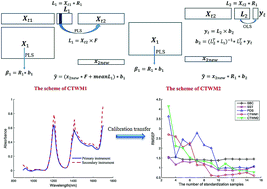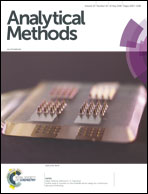Calibration transfer based on the weight matrix (CTWM) of PLS for near infrared (NIR) spectral analysis
Abstract
Calibration transfer is of great necessity for practical applications of near infrared (NIR) spectroscopy, since the original calibration model would become invalid when spectra are measured on different instruments or under different detection conditions. In the calibration transfer method of spectral space transformation (SST) that has shown excellent performance in practice, loadings of PCA have been proven to contain important information about differences between different instruments. Just like the loadings of PCA, the weight matrix of PLS contains much information, including the weights of absorbance at different wavelengths for each PLS factor. In this study, two new calibration transfer methods based on the weight matrix (CTWM) of partial least squares (PLS) were proposed. CTWM1 uses PLS to build a linear regression model between the secondary spectra of standardization samples and the low-dimensional information extracted from the primary spectra of standardization samples using the weight matrix of the original calibration model. CTWM2 retains the weight matrix but uses ordinary least squares (OLS) to update the y-weight vector using the secondary spectra and property values of standardization samples. CTWM1 can be applied to the occasion when both the primary and secondary spectra of standardization samples can be obtained, while CTWM2 can be applied to the occasion when the primary spectra of standardization samples cannot be obtained but the observed property values can be. The only parameter in CTWM1 and CTWM2 is the number of latent variables selected in the weight matrix and it can be set to a reasonable value according to the number of standardization samples and the number of latent variables selected in the original primary calibration model, which means that CTWM1 and CTWM2 have the advantage of easy implementation and are practical for calibration transfer. The performance of CTWM1 and CTWM2 has been tested on two NIR datasets. Compared with slope and bias correction (SBC), spectral space transformation (SST) and piecewise direct standardization (PDS), CTWM1 shows good performance and can give reliable and accurate results. Compared with recalibration using standardization samples, CTWM2 shows good performance when the difference in instrument responses is relatively small.



 Please wait while we load your content...
Please wait while we load your content...